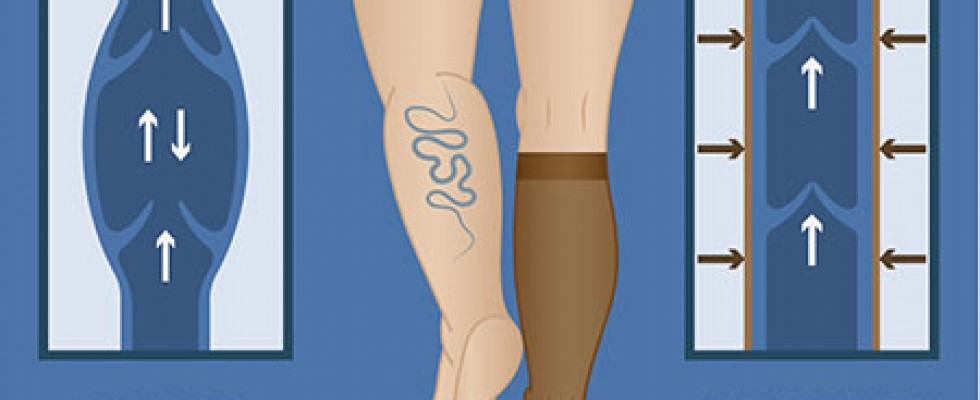
They call the latter part of life the golden years, but those old enough to know better realize it’s not gold—it’s rust. As people age, parts of the body deteriorate, including the one-way valves in leg veins. These seemingly insignificant flaps, actually folded extensions of the vein wall, help prevent gravity from pulling carbon dioxide-laden blood in the leg veins down to the feet and causing swelling.
When you figure that 70% of the body’s blood is in the veins, it’s worth taking notice when visible bulging veins or swelling in the legs appear. These can be signs of venous insufficiency. Some people may not worry until other side effects arise. Skin rash, pigmentation, hardening of the skin, ankle ulcers or bleeding may follow the swelling of veins, which is often overlooked or tolerated. Accompanying symptoms such as aching, throbbing, itching, burning, cramping, heaviness or restless legs may exist in various stages of severity and develop slowly. It’s no wonder that venous disorders are often ignored until they have been present for a long time.
Simple Remedies
Physicians may tell patients that nothing can be done, or they may recommend elastic stockings. Actually, there is a lot that can be done to treat and effectively manage venous disorders and varicose veins.
The mainstay of conservative treatment and the point from which all therapies derive is simple leg elevation. Since elevation is impractical for anyone who wants to leave the house, the alternative is an antigravity device known as reverse gradient compression hosiery. These stockings exert more squeeze at the foot and less pressure higher up to direct fluids upwards. These differ from simple elastic stockings that apply the same amount of pressure throughout. For home medical equipment (HME) providers, there is an opportunity to serve these patients by offering differing degrees of compression.
Compression socks or stockings are an effective tool to help the leg muscles perform a stronger contraction to pump the blood in the leg veins back up to the heart. Recirculation of this oxygen-poor blood, which filled with waste products from tissue metabolism, is critical to allow the lungs to exchange carbon dioxide for oxygen and for the kidneys to eliminate waste products. The reduction of swelling is also vital to prevent the buildup of elevated tissue pressure, which generates inflammation. Physicians and researchers have determined that these inflammatory proteins are responsible for most problems associated with vein disorders.
The hosiery is designed with a built-in gradient to send fluids upwards. This simple action benefits the superficial venous blood and also the deep venous blood movement, which helps prevent deep vein blood clots. It also facilitates the drainage of intercellular fluid by the lymphatic vessels.
Compression Options
The amount of compression needed varies based on the condition being treated. For bed-bound patients, only a light amount of compression is required, usually 8-10 mmHg, because gravity plays a lesser role on bloodflow in the horizontal position. Once someone is sitting or standing, gravity comes into play and there is a need for increased compression. For light everyday use, 10-15 mmHg is recommended. Varicose and spider veins benefit from higher compression of 20-30 mmHg or 30-40 mmHg. Lymphedema patients require even higher compression of 40-50 mmHg.
These stockings or socks are fitted according to ankle and calf circumference. Thigh measurements for garments that reach higher are necessary due to large differences in thigh circumference. There are devices to assist in donning the hosiery ranging from rubber gloves to various bracket frames and sleeves. In addition, wraps with Velcro straps or zippers can assist those with physical limitations or venous ulcers. HME providers can help with fitting compression stockings and provide the assistive devices, which present a good opportunity to upsell a cash purchase.
Compression hosiery can be worn for limited time before and during vein treatment or any time the patient is on their feet or traveling long distances when ambulation is limited. Hosiery feels good due to the additional support it provides and can prevent leg fatigue when someone is standing all day. There are open-toe options that allow sandal wear in warm climates. Providing options should be a priority for HME dealers. One warning, however: If a customer has arterial insufficiency and is experiencing leg cramping when walking, direct them to a physician for proper guidance and treatment.
